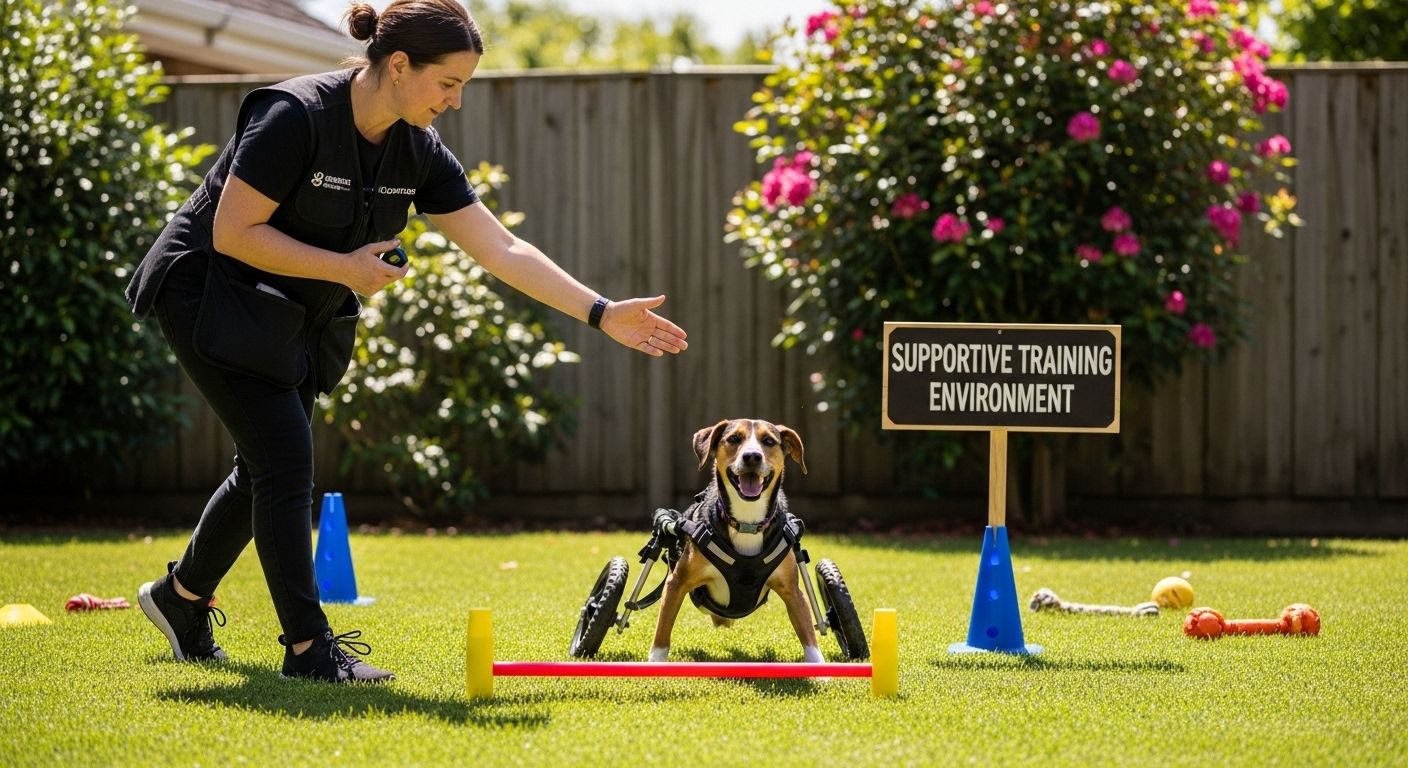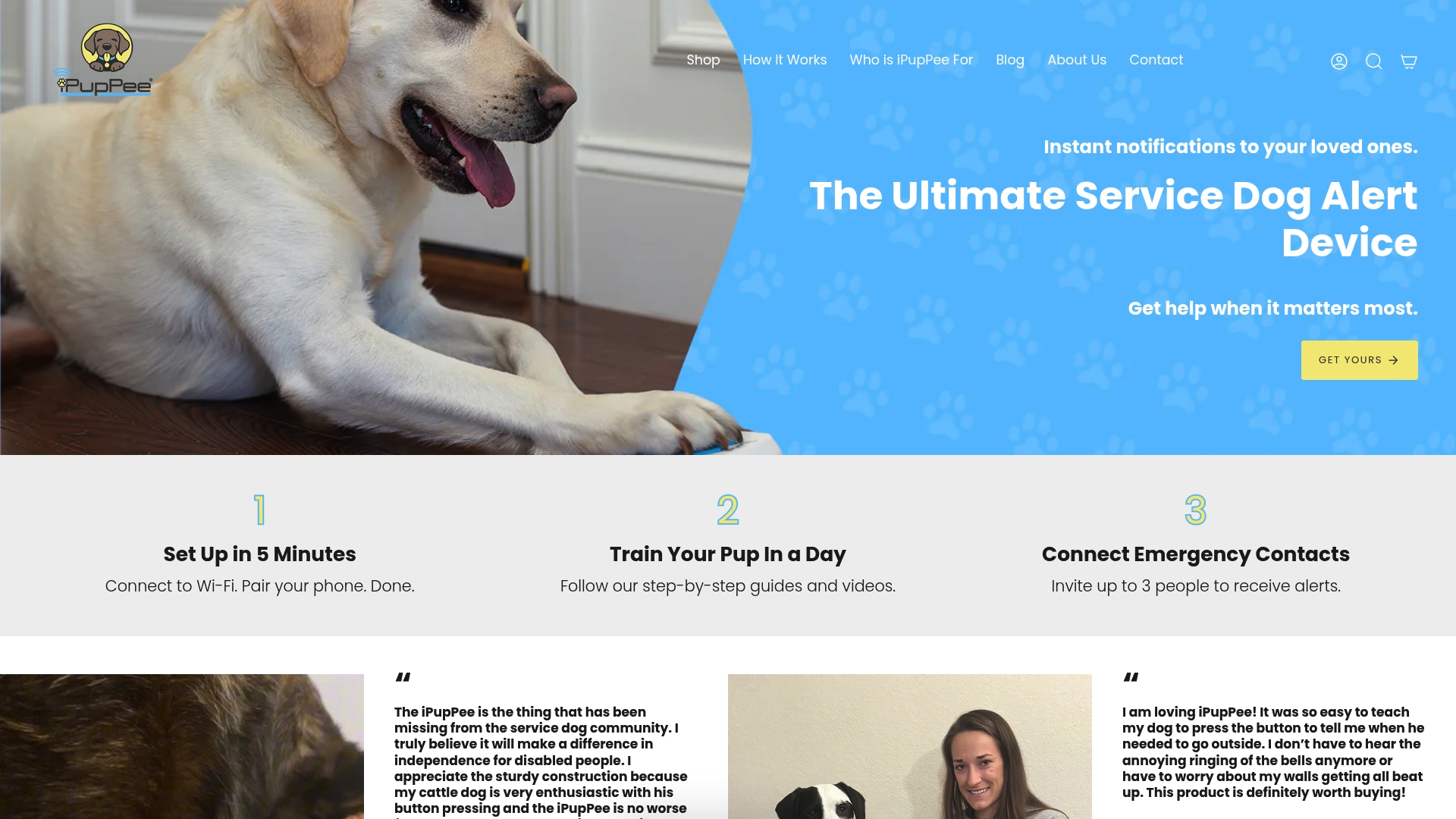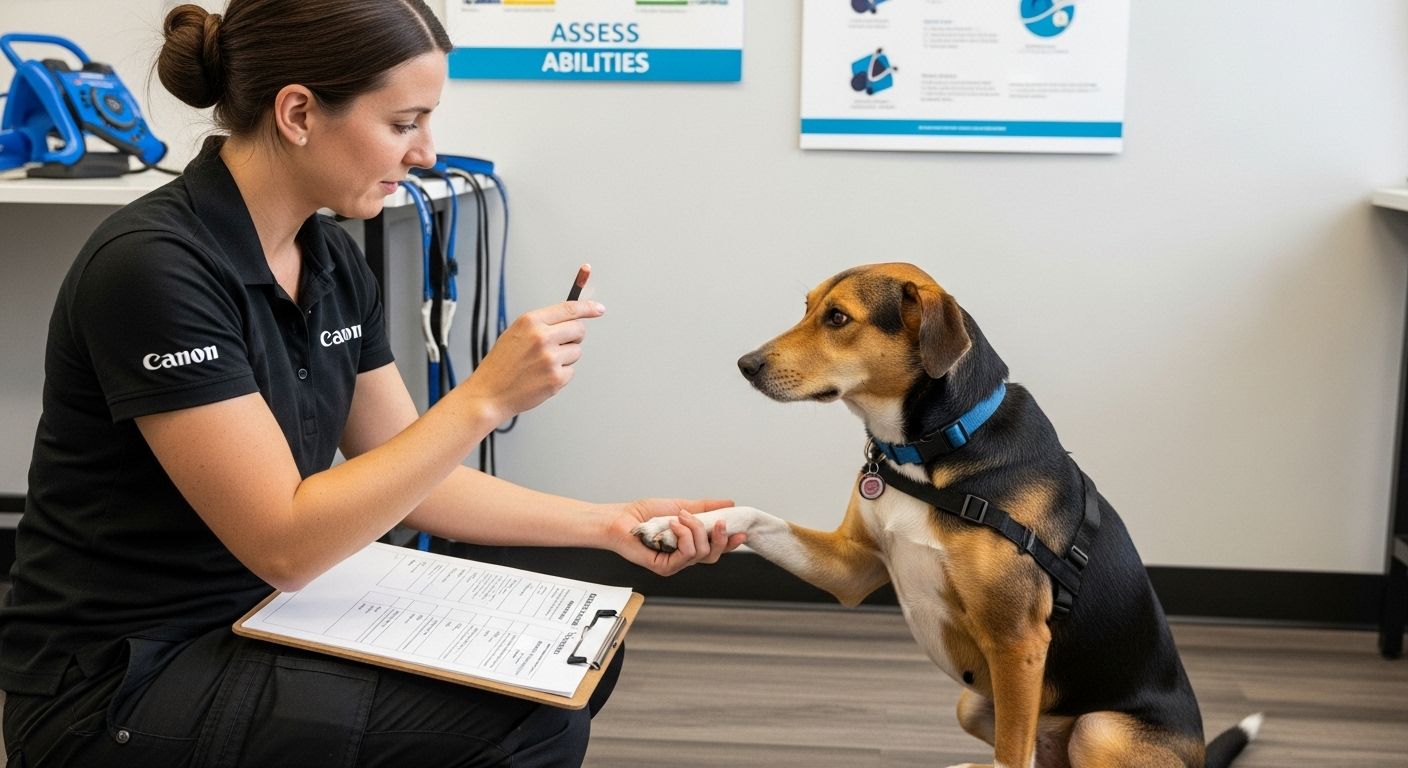Training a disabled dog can feel overwhelming at first. Out of every ten dog owners, only two feel confident adapting communication techniques for disabilities. Yet even the most experienced trainers often miss this simple reality. The magic starts when you see not a disability, but untapped potential waiting for the right approach.
Table of Contents
- Step 1: Assist Your Dog’s Unique Abilities And Needs
- Step 2: Create A Safe And Supportive Training Environment
- Step 3: Develop A Customized Training Plan
- Step 4: Utilize Positive Reinforcement Techniques
- Step 5: Monitor Progress And Adjust Training Methods
- Step 6: Reinforcement Learning Through Consistent Practice
Quick Summary
| Key Point | Explanation |
|---|---|
| 1. Assess Your Dog’s Abilities Thoroughly | Evaluate your dog’s physical and sensory capabilities to craft a personalized training strategy. |
| 2. Create a Safe Training Environment | Design a comfortable, distraction-free space that promotes learning and emotional security for your dog. |
| 3. Develop a Customized Training Plan | Establish clear, measurable goals tailored to your dog’s unique communication abilities and challenges. |
| 4. Use Positive Reinforcement Consistently | Implement timely rewards that motivate your dog, reinforcing desired behaviors through high-value incentives. |
| 5. Monitor Progress and Adjust Techniques | Track training outcomes systematically, being flexible and responsive to your dog’s learning journey and needs. |
Step 1: Assist Your Dog’s Unique Abilities and Needs
Successfully training disabled dogs begins with a comprehensive understanding of your individual dog’s strengths, limitations, and communication capabilities. This critical first step involves carefully evaluating your dog’s physical condition, sensory abilities, temperament, and potential for learning specialized communication techniques.
Starting your training journey requires a nuanced approach that recognizes each dog as a unique individual. Professional veterinarians and specialized animal behaviorists recommend conducting a thorough initial assessment that examines your dog’s physical health, neurological functioning, and psychological readiness for advanced training. This evaluation helps you develop a personalized training strategy tailored to your dog’s specific needs.
A comprehensive assessment involves multiple dimensions of understanding. Physical capability assessment means documenting your dog’s mobility, sensory functions, and any existing medical conditions that might impact training. Some dogs with partial hearing or visual impairments can still learn complex communication techniques through alternative sensory pathways.
Use the table below to compare different communication methods for disabled dogs based on the type of impairment discussed in the article.
| Impairment Type | Recommended Communication Methods | Supporting Tools/Techniques |
|---|---|---|
| Hearing Impairment | Visual signals, hand gestures, flashlights | High-contrast markers, light cues, vibrations |
| Visual Impairment | Tactile cues, consistent spatial arrangements | Non-slip flooring, gentle touch, scent markers |
| Mobility Challenges | Adaptive positioning, touch signals | Support harnesses, stable surfaces, soft bedding |
| Combined Impairments | Multisensory reinforcement | Vibration feedback, scent, carefully timed cues |
Temperament evaluation is equally crucial. Some dogs demonstrate higher adaptability and learning potential, while others might require more patient, incremental training approaches. Observe your dog’s reactions to new stimuli, stress tolerance, and willingness to engage with training exercises. Professional behaviorists suggest recording these observations systematically to track progress and adjust training strategies accordingly.
Key verification indicators that you’ve successfully completed this assessment include:
Below is a checklist summarizing the key verification indicators for successfully assessing your disabled dog’s unique abilities and needs.
| Verification Indicator | Description |
|---|---|
| Detailed documentation of physical and sensory capabilities | Written record of your dog’s mobility, senses, and medical conditions affecting training |
| Clear understanding of potential training challenges | Identification of hurdles or limitations unique to your dog |
| Preliminary identification of communication techniques | Initial idea of which training/communication methods may work best for your dog |
| Systematic temperament and stress tolerance observations | Recorded observations regarding adaptability, learning potential, and reaction to new stimuli |
| Collaboration with veterinarian or behaviorist as needed | Consultation notes confirming input from relevant professionals if applicable |
- Detailed documentation of your dog’s physical and sensory capabilities
- Clear understanding of potential training challenges
- Preliminary identification of communication techniques most likely to succeed
Remember that this initial step is not about limitations but discovering potential. Each dog, regardless of physical challenges, possesses remarkable communication capabilities waiting to be unlocked through patient, personalized training approaches.
![]()
Step 2: Create a Safe and Supportive Training Environment
Establishing a safe and supportive training environment is fundamental when working with disabled dogs. This critical step transforms your training space into a sanctuary of learning, comfort, and positive communication where your dog can feel secure and motivated to engage with new skills.
The physical environment plays a pivotal role in successful training. Begin by designing a dedicated training area that minimizes diStractions and potential sources of stress. Choose a quiet, well-lit space with minimal external noise and consistent temperature. This could be a specific room in your home or a designated area in your backyard that provides both physical and emotional safety for your dog. Explore our comprehensive guide on creating effective training spaces to further optimize your approach.
Sensory considerations are paramount when training disabled dogs. For dogs with hearing or visual impairments, consider using high-contrast colors, clear visual markers, and consistent spatial arrangements that help them navigate and understand their training environment. Soft, non-slip flooring provides comfort and stability, especially for dogs with mobility challenges. Ensure the space is free from sharp edges, unstable furniture, or potential hazards that could cause physical or psychological discomfort.
Emotional support is equally crucial as physical safety. Create a predictable routine with consistent training times and gentle, patient interactions. Use positive reinforcement techniques that build trust and confidence. Soft bedding, familiar toys, and calming pheromone diffusers can help create a nurturing atmosphere that reduces anxiety and promotes learning.
Key verification indicators that you’ve successfully created a supportive training environment include:
The following table provides a checklist of verification indicators to confirm you’ve created a supportive training environment for your disabled dog.
| Verification Indicator | Description |
|---|---|
| Dedicated, distraction-free training space | Selected area with minimal noise and external disruptions |
| Consistent and predictable training setup | Regular schedule and familiar setup maintained for each session |
| Observable comfort and reduced stress | Dog exhibits relaxation and willingness to engage during training |
| Appropriate sensory accommodations | Adjusted lighting, markers, and surface based on dog’s needs |
- A dedicated, distraction-free training space
- Consistent and predictable training setup
- Observable signs of dog comfort and reduced stress during training sessions
Remember that every dog is unique. Remain flexible and willing to adapt your environment based on your dog’s individual responses and needs. The goal is to create a space that feels safe, supportive, and conducive to learning and communication.

Step 3: Develop a Customized Training Plan
Developing a customized training plan is the strategic blueprint that transforms your understanding of your dog’s unique abilities into actionable communication techniques. This critical step requires a detailed, personalized approach that acknowledges your dog’s specific challenges and leverages their individual strengths.
Begin by translating the assessment from the previous step into a structured, goal-oriented training strategy. Prioritize realistic, incremental objectives that build your dog’s confidence and communication skills. Each goal should be specific, measurable, and tailored to your dog’s physical and cognitive capabilities. Discover advanced training methodology for specialized communication to refine your approach.
Consider multiple communication modalities when designing your plan. For dogs with hearing impairments, visual signals like hand gestures become paramount. Dogs with mobility challenges might require alternative communication techniques that rely on touch, body positioning, or adaptive technology. Some dogs respond exceptionally well to vibration-based communication methods or specialized alert systems that provide sensory feedback.
Your training plan should incorporate a balanced mix of skill-building exercises and confidence-boosting interactions. Break complex communication goals into smaller, manageable tasks that prevent overwhelming your dog. Use positive reinforcement techniques that reward incremental progress, creating a motivational learning environment. Document each training session, tracking both challenges and breakthroughs to continuously refine your approach.
Key verification indicators that you’ve successfully developed a customized training plan include:
- Clearly defined, realistic communication goals
- Documented training strategy addressing specific abilities and limitations
- Flexible approach demonstrating willingness to adapt techniques
Remember that a customized training plan is a living document. Remain patient, observant, and willing to adjust your strategies based on your dog’s responses and emerging communication capabilities. The most successful training plans are those that grow and adapt alongside your dog’s unique journey.
Step 4: Utilize Positive Reinforcement Techniques
Positive reinforcement represents the cornerstone of effective communication and training for disabled dogs, transforming learning into a joyful, empowering experience. This approach creates a foundation of trust, motivation, and mutual understanding that transcends traditional training methodologies.
Immediate and consistent rewards are crucial in reinforcing desired behaviors. Choose high-value rewards that specifically motivate your individual dog, which might include special treats, enthusiastic praise, gentle physical affection, or interactive toys. These rewards should be tailored to your dog’s sensory preferences and capabilities. Explore advanced motivation strategies for specialized training to enhance your approach.
The timing and delivery of rewards demand precision and sensitivity, especially when working with disabled dogs. For dogs with sensory impairments, rewards must be clear, consistent, and delivered in a manner that guarantees they understand the connection between their action and the positive outcome. This might involve using distinct tactile signals, vibration-based feedback, or visual markers that communicate success more effectively than traditional verbal praise.
Develop a nuanced reward system that acknowledges incremental progress. Break complex communication tasks into smaller, achievable steps, celebrating each milestone to build your dog’s confidence. Recognize that disabled dogs might require more patience and more frequent reinforcement. Some dogs will need shorter training sessions with more concentrated reward moments, while others might respond better to longer, more immersive training experiences.
Key verification indicators that you’ve successfully implemented positive reinforcement techniques include:
- Consistent improvement in communication skills
- Observable increase in dog’s motivation and engagement
- Demonstrated understanding of reward associations
Remember that positive reinforcement is more than just treats and praise. It’s about creating a supportive, understanding relationship where your dog feels safe, valued, and eager to communicate and learn.
Step 5: Monitor Progress and Adjust Training Methods
Monitoring progress and adapting training methods is a dynamic process that requires continuous observation, documentation, and flexible thinking. This critical step transforms your training approach from a rigid plan into a responsive, adaptive communication strategy tailored to your disabled dog’s unique learning journey.
Systematic documentation becomes your most powerful tool in tracking your dog’s communication development. Create a detailed training journal that records not just achievements, but subtle nuances in your dog’s responses, engagement levels, and potential challenges. Explore our comprehensive guide on tracking training progress to refine your monitoring approach.
Develop multiple assessment methods that accommodate your dog’s specific disabilities. For dogs with sensory impairments, progress might look different compared to traditional training metrics. Visual tracking through video recordings, detailed behavioral checklists, and quantifiable communication milestones provide objective insights into your dog’s learning trajectory. Pay close attention to changes in confidence, willingness to engage, and subtle improvements in communication attempts.
Flexibility is paramount in this stage. When certain training techniques prove less effective, resist the urge to view them as failures. Instead, consider them valuable data points that inform your next approach. Some communication methods might require significant modification or complete replacement based on your dog’s unique learning style and physical capabilities. This might involve experimenting with alternative sensory communication techniques, adjusting reward systems, or breaking down complex tasks into even smaller, more manageable steps.
Key verification indicators that you’ve successfully monitored and adjusted training methods include:
- Consistent and objective documentation of training progress
- Demonstrated ability to modify techniques based on dog’s responses
- Observable improvements in communication skills
Remember that progress is not always linear. Some days will feel like significant leaps forward, while others might seem like setbacks. The most important aspect is maintaining patience, compassion, and an unwavering commitment to understanding your dog’s unique communication potential.
Step 6: Reinforcement Learning Through Consistent Practice
Consistent practice transforms sporadic training attempts into meaningful communication skills for disabled dogs. This crucial step bridges the gap between initial learning and genuine, reliable communication by establishing predictable, structured training routines that build muscle memory, confidence, and mutual understanding.
Short, frequent training sessions prove most effective when working with disabled dogs. These concentrated learning moments should last between 5 to 15 minutes, depending on your dog’s individual attention span and energy levels. Discover techniques for maintaining training momentum to optimize your approach. Focus on creating a consistent environment where your dog can anticipate and participate in communication exercises without feeling overwhelmed.
Design practice sessions that integrate communication techniques seamlessly into daily routines. This might involve using specific hand signals during feeding times, practicing tactile communication while walking, or incorporating visual cues during play. The goal is to make learning feel natural and integrated rather than a formal, high-pressure experience. Disabled dogs often require more repetition and patience, so approach each practice session with calm, positive energy that encourages exploration and builds trust.
Variation prevents training from becoming monotonous. Rotate between different communication exercises, environments, and levels of difficulty to keep your dog engaged and mentally stimulated. Some days might focus on refining existing skills, while others introduce gentle variations that challenge your dog’s communication abilities. Pay close attention to your dog’s body language and energy levels, allowing breaks and providing ample positive reinforcement throughout the process.
Key verification indicators that you’ve successfully reinforced learning through consistent practice include:
- Demonstrated ability to perform communication tasks in multiple environments
- Observable increase in confidence and willingness to engage
- Consistent response to established communication signals
Remember that consistency does not mean rigidity. Your practice sessions should remain flexible, adapting to your dog’s changing needs and celebrating every small breakthrough in your communication journey.
Unlock Better Communication With Your Disabled Dog—Start Today
Does your disabled dog struggle with traditional training or communication tools? If you found value in learning about personalized training plans, sensory-aware environments, and the power of positive reinforcement from our article, imagine accelerating your dog’s progress with tools designed specifically for unique needs. Many pet owners face frustration and concern when their dog cannot easily signal for help or communicate daily needs, especially when disabilities add more complexity.

Give your dog a real voice. The iPupPee alert device creates a simple way for disabled dogs to notify you with just a button press. This empowers your pet while giving you peace of mind through quick, clear communication. Discover how our smart communication products, rich training resources and guides, and customer testimonials can help your dog live more confidently. Visit ipuppee.com now to explore solutions that can transform everyday life for both you and your dog. Take the next step in mastering effective training and see change happen today.
Frequently Asked Questions
What is the first step in training a disabled dog?
The first step in training a disabled dog is to assess their unique abilities and needs. Understanding their physical condition, sensory capabilities, and temperament allows you to develop a personalized training strategy tailored to their strengths and limitations.
How can I create a supportive training environment for my disabled dog?
To create a supportive training environment, designate a quiet, well-lit area free from distractions. Ensure the space is safe and comfortable, using familiar toys and positive reinforcement techniques to build your dog’s confidence and reduce stress during training sessions.
What are effective training techniques for dogs with hearing impairments?
For dogs with hearing impairments, use visual signals such as hand gestures or flashlights to communicate. Consistent spatial arrangements and tactile feedback can also help them understand commands and improve communication skills.
How often should I practice training with my disabled dog?
It’s best to practice in short, frequent sessions lasting between 5 to 15 minutes. Consistent practice helps reinforce communication skills and builds your dog’s confidence while integrating training into daily routines.

